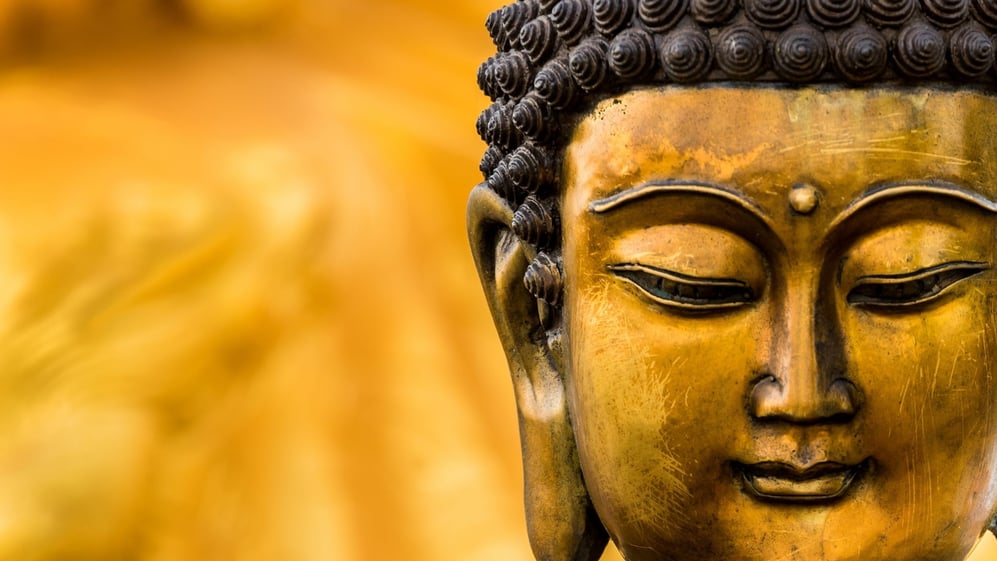In Mark 7:21–23, Jesus says, “For from within, out of the heart of man, come evil thoughts, sexual immorality, theft, murder, adultery, coveting, wickedness, deceit, sensuality, envy, slander, pride, foolishness. All these evil things come from within, and they defile a person.”
As a part of my series on teaching differences between Christianity and other major world religions, I will explain a major world religion with core teaching that is the antithesis of this warning against trusting ourselves—looking inward for peace. That religion is Buddhism.
The Differences in View of Higher Power
It is vital to understand from the outset that Buddhism is a religion without a god or higher power as one would normally think; it is a nontheistic system of belief. Buddhism is more of a path toward deeper insight and wisdom that anyone can take. Buddhism is named after the man who pioneered the path and left a way for others to follow. He never claimed to be a god nor to have divine powers. The word buddha means “enlightened one” or “awakened one” in an ancient language called Sanskrit. In this sense, there are many people who have become buddhas.
The man known as the Buddha was originally named Siddhartha Gautama. He was born in the fifth century BC in what is now Nepal, or northern India. During his life, he encountered much suffering and pain among those around him. Wishing to discover a means of alleviating or eradicating this misery, he charted a course of study with revered teachers. Following a time of intense meditation, he emerged enlightened or awakened, not to teach what he had experienced but rather to coach others on how to reach this enlightenment or awakening themselves. During the rest of his days, Gautama, or “Buddha,” was an itinerant teacher.
Originally a small sect in northern India, Buddhism spread to central and southern Asia, China, Japan, and Korea. In the third century BC, the emperor of India made Buddhism the official religion of the nation. Today, Buddhism has spread all over the world, even to the United States.
Help students to understand that while the teachings of Buddhism are popular worldwide and have had a great deal of influence in the way many people think, they are rooted in one man. The Bible, on the other hand, is the divinely inspired record of what almighty God has done in human history to save sinners. The Bible is a collection of various books recorded over the course of centuries. It is verifiable even by secular history. Ultimately, Buddhism is taken from the meditations of a single person.
What is more, Buddha derived his ideas from a sinful source, that is, his own corrupt heart. Stress for students that when we look within for the answers to life questions, what we find will frequently be wrong and, at best, incomplete. Instead, Christianity directs us outside of ourselves, extra nos in Latin, to a sinless, loving, eternal God who has spoken to His created humanity in His Holy Spirit through the Bible.
What exactly did Buddha teach?
The Differences in Basic Beliefs
Early in his teaching, Buddha presented a set of dictums that is referred to as the Four Noble Truths. Disciples of Buddhism consider them noble in the sense that they reflect reality, are without error, and do not change. As much as these truths are to be taken at face value, Buddhists also test, reflect upon, and apply them.
1. For all living beings life is suffering.
Explain to students that while Buddha was correct in identifying the problem of suffering in the world, he missed the root cause entirely. Suffering is a result of sin, not only the generalized corruption of all humanity but also the specific sins of each individual person.
2. The cause of all suffering is desire.
In a sense, Buddha was correct in asserting that suffering is based in desire. However, there is an important nuance that students shouldn’t miss. God created human beings to desire Him and all His gifts as He gives them. Suffering takes place when we seek to be satisfied outside of God or by His gifts as we would have them. In fact, it was the sinful desire of Adam and Eve to have knowledge like God that cast humanity into the corrupt state in which it now exists.
3. The solution is to purge oneself of desire.
Help students to understand that Buddha tried to ameliorate or even end suffering by dealing with the symptoms. It is our sinful desire that leads us into trouble. It is entirely God-pleasing to desire the things which God gives in this life. Sinful desire does lead to suffering, but that is only a symptom. Sin is the root, and it must be dealt with.
4. There is a path one can follow to achieve this end.
Teach students to guard against the allure of Buddhism that offers a path for human beings to fix themselves. This is entirely at odds with Christianity. Having a “path” is enticing because it feeds the ego and gives a false sense of accomplishment. If mankind were able to fix itself, it would have done so by now. Mankind is fixed by the salvific work of Jesus Christ. His perfect life, innocent death, and resurrection have redeemed a sinful world. God saves us one at a time, through the work of His Holy Spirit in the means of grace: Word and Sacraments.
The Differences in Practices
Buddha established a set of steps to reach this end called the Eight-Fold Path.
- Right view: Understand correctly the Four Noble Truths
- Right thought: This can also be rendered “right intention.” The idea is to cultivate a life free of violence and hatred and instead to pursue a life leading to greater enlightenment and awakening.
- Right speech: Avoid lying, idle talk, divisiveness, and hurtful speech.
- Right action: Behave in a manner free of harm to others or oneself. This harm includes stealing and killing.
- Right livelihood: Make a living in an ethical vocation that does not harm oneself or others.
- Right effort: Work diligently to avoid unhealthy or harmful behaviors and instead cultivate the wholesome.
- Right mindfulness: Use the mind to observe the body, thoughts, and feelings. Do so without bias or judgment.
- Right concentration: Practice meditation regularly and diligently to gain deeper enlightenment and awakening.
Lead students through an examination of the Eightfold Path. Help them to find similarities with the Ten Commandments. The goal is to teach not that all religions are basically the same but rather that Buddhism reflects what God has written on the heart of man and what He gave the people of Israel at Mount Sinai. Direct students to the insight that the Eightfold Path teaches nothing that the Bible doesn’t regarding right living. The problem is that sinful humans cannot keep the Eightfold Path any better than the Ten Commandments. As the Bible teaches, if we try to keep the Law, we will fail and find nothing but frustration. More important, without Jesus Christ, God rejects any good works. Trying to earn salvation brings nothing but eternal damnation.
The Differences in Worship
As there is no god to speak of in Buddhism, it is challenging to define a practice of worship as Christianity or other theistic religions might define it. Rather, Buddhists “worship” through meditation and practice of the Eightfold Path.
Contrary to the belief of some, Buddhists do not believe or teach reincarnation as in Hinduism and other Indian belief systems. Instead, the goal of Buddhism is Nirvana. Nirvana is the ultimate state of enlightenment. It is a complete purging and cessation of desire that leads to suffering.
Remind students that meditation as taught by Buddhism is ultimately looking inside oneself for peace and insight. Within ourselves, we find only the devil, the influence of the world, and our own sinful ideas. Suggest to students the practice of meditating on God’s Word. Teach students to select a passage of Holy Scripture to read, study, pray over, and inwardly digest. Examples include praying the Psalms, memorizing short verses from Paul’s letters, and picturing the events of the parable of the prodigal son in one’s imagination.
Conclusion
Ultimately, like all non-Christian religions, Buddhism leads sinners to try to solve the problem of sin by their own efforts. Buddhism seeks not even to eradicate the root problem but to treat one of the symptoms: desire. Christianity also teaches resistance against desire but only sinful desire. What is more, Christians resist sinful desire not to reach deeper enlightenment but rather as a loving, obedient response to God’s action for us. Left to ourselves, we will always fail to resist sinful desire. There can only be success with the help of the Holy Spirit.
Finally, show students that Buddhism directs people away from God and toward themselves. God’s Word teaches the truth of a God who in mercy and love, entered a world of suffering in His Son, Jesus Christ. Jesus endured a lifetime of suffering—most importantly on the cross. In doing so, He brought an ultimate end to human suffering through the forgiveness of sins and the gift of everlasting life in heaven.
Scripture: ESV®.
 This study examines Christianity and fourteen other religions, identifying the central teachings of each and providing some tools for Christians who encounter people of other beliefs in their daily lives.
This study examines Christianity and fourteen other religions, identifying the central teachings of each and providing some tools for Christians who encounter people of other beliefs in their daily lives.













